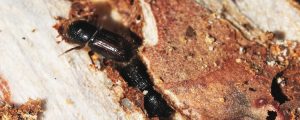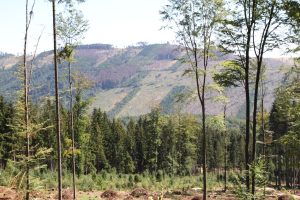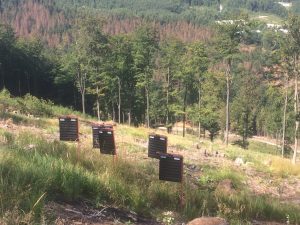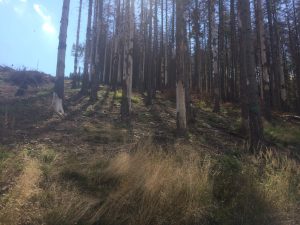After the extremely dry summer in 2018, the spruce forests in parts of Europe have been affected by stress-related damages which have made the spruce trees less resistant against the bark-beetle (Ips typographus). We take a look at the current situation in the most affected countries in Europe.
France
In France, the northeastern parts, Grand-Est and Bourgogne, are the most affected. According to alim’agri, the ministry of agriculture, approximately 7 million cubic meters, or 20 000 hectares, needs to be cut as soon as possible to limit the damages. In the areas above 800 – 900 meters altitude the damages are limited.
The area has had two years in a row with extreme weather conditions; 2018 was the warmest summer since 1900, and 2019 had two major heat waves with a severe drought that followed. The authorities fear that the damages during spring and summer of 2020 could be just as extensive as 2019.
Photo: Swedish Forest Agency (Skogsstyrelsen)
Czech Republic
The Czech Republic is one of, probably even the most bark-beetle affected country in Europe and the current crisis are the worst ever of its kind in the country. One reason is that they have large monocultural coniferous forests, another explanation is the regulations for felling.
For felling afflicted trees in the Czech Republic, the forest owner has to announce a public tender. This slows the process down so much that the bark-beetle often has already left the trees when the time comes, and it doesn’t make sense to cut them down anymore. This is, of course, a problem as the trees normally have to be cut when the beetles are still in them – when the trees are still green.
Photo: Per Jonsson
According to the think-tank Czech Forest, 30 million cubic meters were lost to the bark-beetle in 2019 which is almost twice as much as in 2018 when it was 18 million. Their estimation for 2020 is 40 – 60 million cubic meters and for 2021 80 – 120 million cubic meters. After that, the afflicted volumes will decrease as the spruce forests in the country slowly disappears.
To stop the calamity seems to be too late, according to experts. It’s being discussed what to do to prevent situations like this in the future. One solution could be to create mixed forests instead of today’s monocultures.
Photo Per Jonsson
Sweden
Swedish Forest Agency (Skogsstyrelsen) wrote in a press release on 18th February 2020, referring to research made by the Swedish University for Agricultural Sciences (SLU), that the damages of the bark-beetle will be less in 2020 compared to 2019 if there will be a normal summer. This is explained by the fact that the regeneration of the beetle decreased during the summer of 2019. However, the estimated damages in 2020 will still be very high.
The main reason for the decrease of regeneration seems to be that the density of the attacks was higher in 2019 compared to 2018, meaning that more bark-beetles competed on the same trees which yielded fewer offspring. The higher density of attacks could be explained by that the spruce trees had recovered to some extent from the extremely dry summer of 2018 and were less stressed and receptive to attacks in 2019.
But it´s not over yet
Nevertheless, the bark-beetle damages in Sweden were twice as high in 2019 compared to 2018 – between 7 and 10 million cubic meters (3 – 4 million in 2018). The total damages 2018 – 2019 are the worst bark-beetle attacks ever (since the measuring started) in Sweden. In the southeastern parts of the country, which have been the worst affected areas so far, the damages are expected to decrease, but further north, in mid-Sweden, the damages will increase.
The development of the situation will, as in 2018 and 2019, be dependent on the weather. Even when huge efforts are put into harvesting and removing the damaged timber from the forest, it is still difficult to raise enough resources to cover the needs in the current situation, even if the problem moves from the southeast to mid-Sweden.
The annual cut in Sweden is 90 million cubic meters on bark.
Photo: Per Jonsson
Germany
Nowadays, Germany should be used to forest disasters. In the ’80s and ’90s they had the “forest death” (Waldsterben) caused by acid rain and air pollution. In the early, and late ’90s, there were extensive storms that caused millions of cubic meters of windthrown trees. Also in 2001 and 2007, some storms caused a lot of problems and costs for the German forestry.
The bark-beetle and drought damages in 2018 and 2019 seem however to be the worst calamity so far. During those two years, 160 million cubic meters have been damaged in an area of 245 000 hectares, which is 2,1 % of the total forest area in Germany. For 2020 it´s estimated approximately the same volumes as in 2019.
After the short-term actions of removing the infected trees from the forest and store the timber for later use, the focus will be on the future forests. The aim is to create “stable, site-specific mixed forests from coniferous and hardwood”.
The normal annual cut in Germany is 53,5 million cubic meters under bark (2017).
Summary
This was a very brief presentation of the current situation in Europe. There are of course also other countries in Europe that have been afflicted. We will have good reasons to get back to them, and this theme later.
Sources: alim’agri, the ministry of agriculture in France, think-tank Czech Forest, Swedish Forest Agency (Skogsstyrelsen), Swedish University for Agricultural Sciences (SLU), Technische Universität Dresden Germany, DLG Germany, Tagesschau.de, Destatis.de.
Please note that different countries use different methods for measuring wood. Therefore, the figures from different countries in this article are not always comparable.















